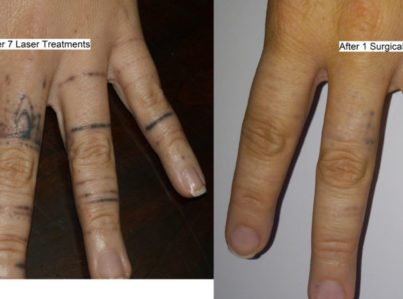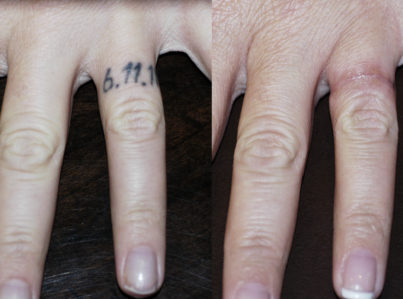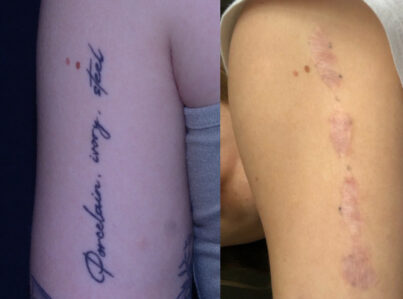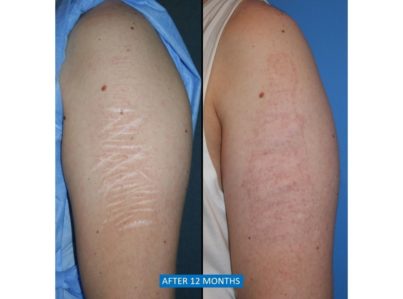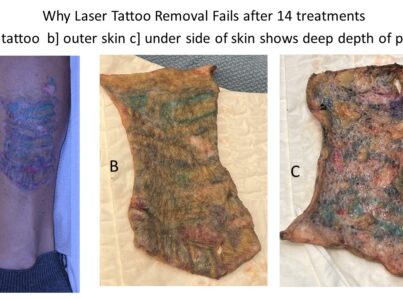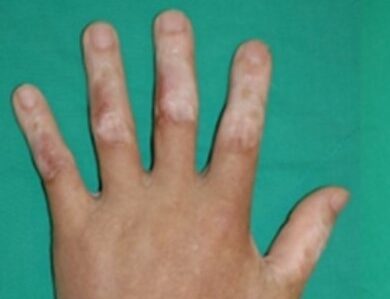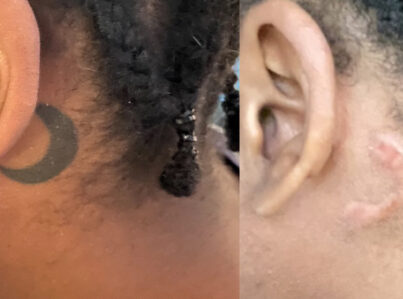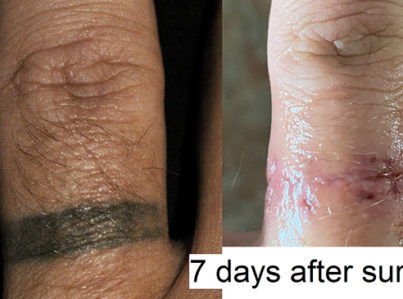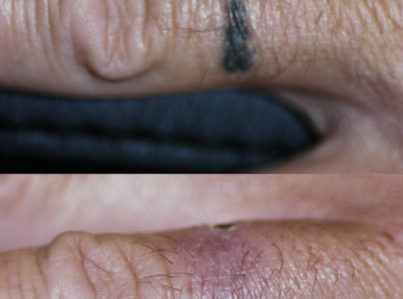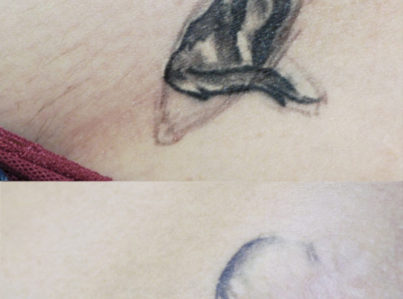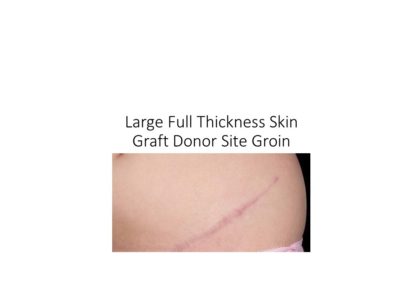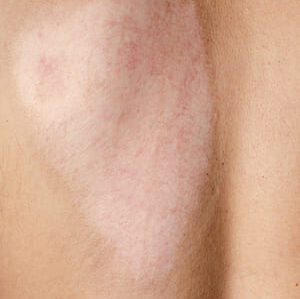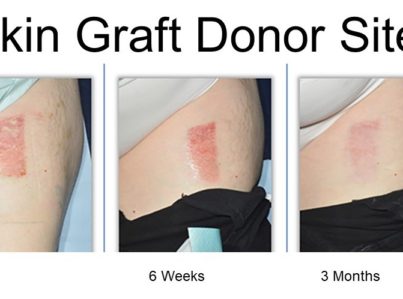What is tattoo removal?
Often One-Stage Tattoo Removal for those hopeful to work as a flight attendant or US Armed Forces
Tattoo removal can be achieved in a number of ways. Many patients have an urgent need for tattoo removal. Many are hopeful to get a job as a flight attendant or enter the armed forces. Often they are not allowed to do so because of a tattoo. Airlines and the Armed Forces allow scars where tattoos used to be present. For many, they prefer to have a scar, and be eligible to employment, rather than have to wait as much as a year for laser treatments to be completed. Surgical tattoo removal is an attractive option for these people. Many fly in and fly out in the same day.
Laser tattoo removal
Lasers are the most common method of tattoo removal performed today. Tattoos consist of thousands of particles of tattoo ink suspended in the skin. The normal human immune system typically removes small foreign particles from the skin. Tattoo ink particles are too big to be removed by this system and are thus considered permanent. The use of lasers helps to break up these particles into smaller pieces that can be removed by the immune system.
Depending on the tattoo design, size and color, it may take 1-10 laser sessions to remove the ink. Some colors of ink are harder to remove than others and may not be able to be completely removed. There should be a six-week time period between each laser session to allow the wounds to heal and the body to absorb as much of the ink as is possible.
Laser tattoo removal is somewhat painful.
Other methods of tattoo removal are more invasive than laser removal and are therefore less commonly performed today. These methods include dermabrasion, chemical peels and surgical excision of the tattoo.
Dermabrasion tattoo removal
Dermabrasion is a surgical method of tattoo removal that involves the use of a medical grinding tool that is used to remove the outer layers of the skin in a controlled manner. The intent is to remove the layers of the skin that contain the ink particles, thereby removing the tattoo.
This procedure is painful and because of this, is typically performed with either a local, regional or even a general anesthetic.
Like laser tattoo removal, a session of dermabrasion will result in an open wound that needs care after the procedure is done The wounds created as a result of dermabrasion typically take longer to heal than those created by laser tattoo removal. These are likely to take somewhere around 10-14 days to heal.
Also, like laser tattoo removal, more than one session of dermabrasion may be necessary to remove a particular tattoo.
Dermabrasion can result in significant scaring and should only be performed by physicians well trained in the proper technique.
Chemical peel tattoo removal
Trichloroacetic acid (TCA) peels can also be used to remove tattoos. TCA is a mild acid that is applied to the skin to remove the outer layers of the skin, and with them, the tattoo ink.
This type of procedure may be mildly painful, but typically does not require the use of an anesthetic.
Like the other types of tattoo removal, TCA peels will result in an open wound that will need to be cared for after the procedure is completed. These wounds will typically heal in approximately 5-7 days.
Surgical excision tattoo removal
Tattoos may also be removed by direct surgical excision. This involves simply cutting out the skin that contains the tattoo. This technique is best used for small tattoos and may not be practical for very large tattoos. The skin surrounding the tattoo is then brought together and closed.
This type of tattoo removal will likely require the use of a local, regional or even a general anesthesia depending on the size of the tattoo. A surgical scar will be created by this type of tattoo removal.
Post-procedure bandages should be left in place for 48 hours. Once the bandages are removed and the surgical site should be cleaned daily with soap and water. A dressing may be applied to cover the wound for the first week after surgery.
Skin grafting may be used to close a larger wound.
Does tattoo removal hurt?
There is some degree of discomfort when getting a tattoo removed, although the pain is relatively manageable. The only discomfort should be the injection of the local anesthetic.
Tattoo removal healing
It will take some time for the skin to heal after tattoo removal. Most side effects are temporary, with the most common reactions being redness, swelling, bruising, scabbing and tenderness. Most of the time these reactions resolve within a week.
All tattoos can be considered for removal.
If you are considering having a tattoo removed, visit Dr Richard Sadove to discuss options for tattoo removal and reasonable expectations.
You may be a candidate for tattoo removal if:
- Are physically healthy
- Don’t smoke
- Have realistic expectations
The average cost of laser tattoo removal is $423, according to 2020 statistics from the American Society of Plastic Surgeons. It is important to consider the type of procedure being performed. Options such as surgical excision and skin grafting are likely to be much more expensive than laser treatments.
Patients should also consider the number of treatments that may be necessary to treat a particular tattoo. Large, colorful and elaborately designed tattoos are likely to require more removal sessions with lasers, and will, therefore, be more expensive to remove. Most health insurance does not cover cosmetic surgery or its complications, but many plastic surgeons offer patient financing plans, so be sure to ask.
- Surgeon’s fe
- Procedure costs
- Facility costs
- Anesthesia fees
- Prescriptions for medication
- Medical tests
When choosing a board-certified plastic surgeon in your area for tattoo removal, remember that the surgeon’s experience and your comfort with him or her are just as important as the final cost of the procedure. Dr Richard Sadove’s experience is over 30 years.
The success and safety of your tattoo removal procedure depends very much on your complete candidness during your consultation. You’ll be asked a number of questions about your health, desires and lifestyle.
During your tattoo removal consultation be prepared to discuss:
- Your tattoo removal goals
- Any medical conditions, drug allergies and medical treatments
- Current medications, vitamins, herbal supplements, alcohol, tobacco and drug use
- Previous surgeries
Dr Sadove will also:
- Evaluate your general health status and any pre-existing health conditions or risk factors
- Take photographs
- Discuss your options and recommend a course of treatment
- Discuss likely outcomes of tattoo removal and any risks or potential complications
Be sure to ask Dr Sadove questions. It’s very important to understand all aspects of your tattoo removal procedure.
It’s natural to feel some anxiety, whether it’s excitement for your anticipated new look or a bit of preoperative stress. Don’t be shy about discussing these feelings with Dr Sadove. He is very easy to speak with him.
Use this checklist as a guide during your tattoo removal consultation:
- Are you certified by the American Board of Plastic Surgery?
- Were you specifically trained in the field of plastic surgery?
- How many years of plastic surgery training have you had?
- What specific training do you have in tattoo removal?
- Do you have hospital privileges to perform this procedure? If so, at which hospitals?
- Is the office-based surgical facility accredited by a nationally- or state-recognized accrediting agency, or is it state-licensed or Medicare-certified?
- Am I a good candidate for this procedure?
- What will be expected of me to get the best results?
- Where and how will you perform my procedure?
- How long of a recovery period can I expect, and what kind of help will I need during my recovery?
- What are the risks and complications associated with my procedure?
- How are complications handled?
- How can I expect my tattoo removal procedure to look over time?
- What are my options if I am dissatisfied with the cosmetic outcome of my procedure?
- Do you have before-and-after photos I can look at for this procedure and what results are reasonable for me?
The decision to have a tattoo removed is extremely personal. Only you can decide if the benefits of tattoo removal will achieve your goals and if the risks and potential complications of tattoo removal are acceptable.
Dr Richard Sadove will explain in detail the risks associated with tattoo removal. You will be asked to sign consent forms to ensure that you fully understand the procedures you will undergo and any risks or potential complications.
The potential risks of tattoo removal include, but are not limited to:
- Infection
- Poor wound healing
- Possible need for further surgery
- Skin discoloration that may be permanent
- Suboptimal aesthetic result
- Unfavorable scarring
These risks and others will be fully discussed with you prior to your consent to perform the procedure. It is important that you address all your questions directly with your plastic surgeon.
No matter which type of tattoo removal procedure you have performed, you will have a gauze bandage applied to the area after the procedure is done. Your surgeon will discuss with you how to care for the area after the procedure is done. Typically, this will require no more than washing the area daily with soap and water and applying a new gauze dressing.
You will be given specific instructions that may include:
- How to care for you surgical sites following the procedure
- Medications to apply or to take orally to aid healing and reduce risk of infection
- Specific concerns to look for at the surgical site or in your general health
- When to follow up with your plastic surgeon
Be sure to ask your plastic surgeon specific questions about what you can expect during your individual recovery period.
- What medications will I be given or prescribed after surgery?
- Will I have dressings/bandages after the procedure? When will they be removed?
- When can I bathe or shower?
- When can I resume normal activity and exercise?
- When do I return for follow up?
The results of tattoo removal are variable depending on the treatment option used for your case. Some treatment options require several sessions, so results will not be immediate. Each session will show some progress toward the final result, though the number of treatments needed to achieve your final result may vary.
Results for tattoo removal are variable and dependent on factors such as:
- The type of procedure used
- The area of the body the tattoo is located in
- The size of the tattoo
- The complexity of the design of the tattoo
- The color of ink used in the tattoo
For optimal results, it is important that you take proper care of the wounds following your tattoo removal procedure. Be sure to follow your surgeon’s post-operative instructions and clean the wound with soap and water daily.
Complete removal of the tattoo is the ultimate goal for any tattoo removal procedures. However, patients should have realistic expectations based on the factors referenced above. Regardless of which treatment is used, it may not be possible to completely remove the entire tattoo. For patients who have their tattoo removed using surgical excision, it’s important to understand that there will be a surgical scar left behind.
Tattoo removal involves many choices. The first and most important is selecting a doctor like DrSadove that you can trust who is a member of the American Society of Plastic Surgeons (ASPS).

